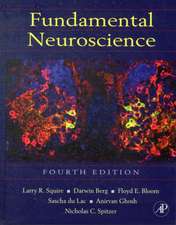Neuroendocrinology: Retrospect and Perspectives
Editat de Horst-Werner Korf, Klaus-Henning Usadelen Limba Engleză Paperback – 30 sep 2011
Preț: 952.26 lei
Preț vechi: 1161.29 lei
-18% Nou
Puncte Express: 1428
Preț estimativ în valută:
182.24€ • 188.26$ • 151.67£
182.24€ • 188.26$ • 151.67£
Carte tipărită la comandă
Livrare economică 25 martie-08 aprilie
Preluare comenzi: 021 569.72.76
Specificații
ISBN-13: 9783642646058
ISBN-10: 3642646050
Pagini: 460
Ilustrații: X, 444 p.
Dimensiuni: 155 x 235 x 24 mm
Greutate: 0.64 kg
Ediția:Softcover reprint of the original 1st ed. 1997
Editura: Springer Berlin, Heidelberg
Colecția Springer
Locul publicării:Berlin, Heidelberg, Germany
ISBN-10: 3642646050
Pagini: 460
Ilustrații: X, 444 p.
Dimensiuni: 155 x 235 x 24 mm
Greutate: 0.64 kg
Ediția:Softcover reprint of the original 1st ed. 1997
Editura: Springer Berlin, Heidelberg
Colecția Springer
Locul publicării:Berlin, Heidelberg, Germany
Public țintă
ResearchDescriere
70 years after the discovery of secretory neurons, internationally leading experts gathered to discuss the latest developments in neuropeptide research and endocrinology, concentrating on the molecular, cellular, supracellular and systemic aspects. A variety of neuropeptidergic systems are considered under comparative and evolutionary aspects.
Cuprins
1. Ernst and Berta Scharrer — Pioneers in Neuroendocrinology.- 2. The Ups and Downs of Neuropeptides.- 3. Neurohormones and Neurohormone Receptors in Invertebrates.- 4. Components of the Neuroendocrine Exocytosis Apparatus.- 5. Neuroendocrine Cells Revisited: A System for Studying Subcellular mRNA Compartmentalization.- 6. Peptide-Secreting Dendrites: New Controls for Neuroendocrine Neurons.- 7. Intracerebral Release of Vasopressin and Oxytocin: New Aspects of the Old Concept of Neurosecretion.- 8. Effects of Neuropeptides on Brain Function in Humans.- 9. Reduced Number of Nitric Oxide Synthase Immunoreactive Neurons in the Nucleus Paraventricularis Hypothalami of Depressed Patients and Schizophrenics.- 10. Neurofibrillary Degeneration in Hypophysiotrophic Nuclei of the Aging Human Hypothalamus.- 11. Sexual Dimorphism, Steroid-Induced Plasticity, and Behavioral Significance of the Vasotocinergic Innervation of the Avian Brain.- 12. The Stimulatory Action of the Glutamate Agonist, N-Methyl-Aspartate, on Luteinizing Hormone Release in the Cockerel with Immunocytochemical Observations on Its Mode of Action.- 13. Neuroendocrine Role of Receptors for Insulin and IGF-1 in the Pituitary Gland: Morphological Considerations.- 14. Insulin-Like Growth Factor I in Bony Fish.- 15. Corticosterone Upregulates Hippocampal Calbindin-D28k in a Region-Specific Manner and Exacerbates Ischemic Neuronal Damage Exclusively in Non-Calbindinergic Neurons.- 16. Structural Evidence for Direct and Indirect Neuro-Endocrine Interactions in the Human Adrenal Cortex.- 17. Neuroepithelial Bodies in Vertebrate Lungs.- 18. Control of the Release of Plasma Catecholamines.- 19. Lysenin, a Novel Bioactive Protein Isolated from Coelomic Fluid of the Earthworm Eisenia foetida — Structure, Secretion and Biological Activity.- 20. Receptors and Effects of the Inhibitory Neuropeptide Somatostatin in Glial Derivatives.- 21. Specific Glycoproteins of the Subcommissural Organ/Reissner’s Fiber Complex: Molecular and Functional Evidence of their Involvement in Developmental Events.- 22. Development and Differentiation of Blood Vessels in the Central Nervous System.- 23. Melatonin Inhibits the PACAP-Induced Phosphorylation of the Transcription Factor CREB in the Rat Suprachiasmatic Nucleus.- 24. Transcription Factors in the Photoneuroendocrine System.- 25. Expression of Nitric Oxide Synthase I Determines the Strength of Adrenergic Cyclic GMP Response in the Rat Pineal Gland.- 26. Noradrenergic and VTPergic Signal Transduction in Rat Pinealocytes.- 27. Morphological Characterization of Rat Pineal Explant Cultures.- 28. Changes in the Three-Dimensional Structure of Synaptic Ribbons in the Pineal Gland of the Guinea-Pig Caused by Constant Light.- 29. Immunocompetent Cells in the Rat Pineal Gland with Special Reference to Macrophages and Dendritic Cells.- 30. Melatonin Synthesis and Calcium Responses in the Pineal Gland of the Trout.- 31. The Work of Ludwig Edinger and His Neurology Institute.
Textul de pe ultima copertă
70 years after the discovery of secretory neurons, internationally leading experts gathered to discuss the latest developments in neuropeptide research and endocrinology, concentrating on the molecular, cellular, supracellular and systemic aspects. A variety of neuropeptidergic systems are considered under comparative and evolutionary aspects.











